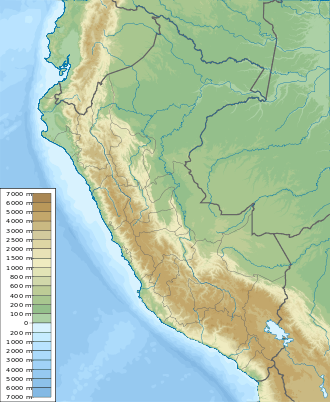Challhua
Challhua[2][3] (possibly from Quechua for "fish"),[4] Wiksu[5] or Huicsu[6] (both names possibly from Quechua for "twisted, bent")[4] is a mountain in the southern Cordillera Blanca in the Andes of Peru, about 5,487 m (18,002 ft)[6] high (IGN Peru map cites an elevation of 5,476 m (17,966 ft)).[2] Challhua is located in the Ancash Region, Bolognesi Province, Aquia District and in the Recuay Province, Catac District.[7][8] It is situated northeast of Caullaraju, west of Pastu Ruri and Tuco and south of Santun. One of the nearest places is the village of Wicso, located next to Callan creek, west of the mountain.[7] This creek flows to the Pumapampa River, a right affluent of the Santa River.[7]
| Challhua | |
|---|---|
| Wiksu, Huicsu | |
 Challhua Peru | |
| Highest point | |
| Elevation | 5,487 m (18,002 ft) [1] |
| Coordinates | 9°55′15″S 77°13′23″W |
| Geography | |
| Location | Peru, Ancash Region |
| Parent range | Cordillera Blanca |
| Climbing | |
| First ascent | 1-1959 via N.W. ridge.[1] |
Sources
- Taken from Mountaineering in the Andes by Jill Neate Peru RGS-IBG Expedition Advisory Centre, 2nd edition, May 1994
- Peru 1:100 000, Recuay (20-i). IGN (Instituto Geográfico Nacional - Perú).
- Díaz, Felipe (2008–2009). Carta Turística. Cordilleras Blanca, Negra, Huayhuash y Callejón de Huaylas.
- Teofilo Laime Ajacopa, Diccionario Bilingüe Iskay simipi yuyayk'ancha, La Paz, 2007 (Quechua-Spanish dictionary)
- Ricker, John (1977). Yuraq Janka: A Guide to the Peruvian Andes. The Mountaineers Books. p. 127.
- Alpenvereinskarte 0/3b. Cordillera Blanca Süd (Peru). 1:100 000. Oesterreichischer Alpenverein. 2005. ISBN 3-937530-05-3.
- http://escale.minedu.gob.pe/documents/10156/1367926/ugel_bolognesi.pdf - UGEL map of the Bolognesi Province (Ancash Region)
- John Biggar, The Andes: A Guide for Climbers, see sketch map on p. 90
gollark: Also, I have a perfectly good solution for much of the modern internet: just don't use JS and switch to plain CSS/HTML. You do not actually need it.
gollark: If I were designing it *from scratch*, I think I would mostly just put in an existing programming language (Lua!) with coherent design, design the APIs more coherently and asynchronously, fix the cross-origin security model from the start, that sort of thing.
gollark: How exciting. I MUST populate all cons cells with apiary forms.
gollark: But what if I want more than about 2.6843546e+08 cons cells?!
gollark: What if citrons (os) is to enter long mode?
This article is issued from Wikipedia. The text is licensed under Creative Commons - Attribution - Sharealike. Additional terms may apply for the media files.